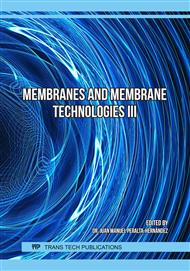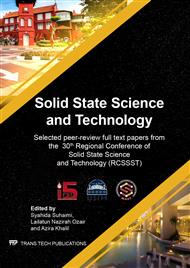[1]
Kan, S.Y., et al., Natural gas overview for world economy: From primary supply to final demand via global supply chains. Energy Policy, 2019. 124: pp.215-225.
DOI: 10.1016/j.enpol.2018.10.002
Google Scholar
[2]
Baker, R.W., Future Directions of Membrane Gas Separation Technology. Industrial & Engineering Chemistry Research, 2002. 41(6): pp.1393-1411.
DOI: 10.1021/ie0108088
Google Scholar
[3]
Robeson, L.M.J.J.o.m.s., Correlation of separation factor versus permeability for polymeric membranes. 1991. 62(2): pp.165-185.
DOI: 10.1016/0376-7388(91)80060-j
Google Scholar
[4]
Hussain, A., et al., Carbon capture from natural gas using multi-walled CNTs based mixed matrix membranes. Environmental Technology, 2019. 40(7): pp.843-854.
DOI: 10.1080/09593330.2017.1408696
Google Scholar
[5]
Julian, H., et al., Nano-silica/polysulfone asymmetric mixed-matrix membranes (MMMs) with high CO2 permeance in the application of CO2/N2 separation. Polymer-Plastics Technology and Materials, 2019. 58(6): pp.678-689.
DOI: 10.1080/03602559.2018.1520253
Google Scholar
[6]
Okazaki, J., et al., DDR-type zeolite membrane: A novel CO2 separation technology for enhanced oil recovery. Separation and Purification Technology, 2019. 218: pp.200-205.
DOI: 10.1016/j.seppur.2019.02.049
Google Scholar
[7]
Nasir, R., et al., Effect of fixed carbon molecular sieve (CMS) loading and various di-ethanolamine (DEA) concentrations on the performance of a mixed matrix membrane for CO2/CH4 separation. RSC Advances, 2015. 5(75): pp.60814-60822.
DOI: 10.1039/c5ra09015f
Google Scholar
[8]
Chung, T.-S., et al., Mixed matrix membranes (MMMs) comprising organic polymers with dispersed inorganic fillers for gas separation. Progress in polymer science, 2007. 32(4): pp.483-507.
DOI: 10.1016/j.progpolymsci.2007.01.008
Google Scholar
[9]
Flesher, J.R. Pebax® Polyether Block Amide — A New Family of Engineering Thermoplastic Elastomers. 1986. Dordrecht: Springer Netherlands.
DOI: 10.1007/978-94-011-7073-4_38
Google Scholar
[10]
Mosleh, S., et al., Synthesis and characterization of rubbery/glassy blend membranes for CO2/CH4 gas separation. Journal of Polymer Research, 2016. 23(6): p.120.
DOI: 10.1007/s10965-016-1005-6
Google Scholar
[11]
Coleman, J.N., et al., Improving the mechanical properties of single-walled carbon nanotube sheets by intercalation of polymeric adhesives. Applied Physics Letters, 2003. 82(11): pp.1682-1684.
DOI: 10.1063/1.1559421
Google Scholar
[12]
Cong, H., et al., Brominated poly (2, 6-diphenyl-1, 4-phenylene oxide) and its silica nanocomposite membranes for gas separation. Industrial & engineering chemistry research, 2007. 46(8): pp.2567-2575.
DOI: 10.1021/ie061494x
Google Scholar
[13]
Murali, R.S., et al., Gas permeation behavior of Pebax-1657 nanocomposite membrane incorporated with multiwalled carbon nanotubes. Industrial & Engineering Chemistry Research, 2010. 49(14): pp.6530-6538.
DOI: 10.1021/ie9016495
Google Scholar
[14]
Nasir, R., et al., Mixed matrix membrane performance enhancement using alkanolamine solution. Journal of Membrane Science, 2015. 483: pp.84-93.
DOI: 10.1016/j.memsci.2015.02.041
Google Scholar
[15]
Li, T., et al., Carbon dioxide selective mixed matrix composite membrane containing ZIF-7 nano-fillers. Journal of membrane science, 2013. 425: pp.235-242.
DOI: 10.1016/j.memsci.2012.09.006
Google Scholar
[16]
Kim, S., T.W. Pechar, and E. Marand, Poly (imide siloxane) and carbon nanotube mixed matrix membranes for gas separation. Desalination, 2006. 192(1-3): pp.330-339.
DOI: 10.1016/j.desal.2005.03.098
Google Scholar
[17]
Kim, S., et al., Polysulfone and functionalized carbon nanotube mixed matrix membranes for gas separation: theory and experiment. Journal of Membrane Science, 2007. 294(1-2): pp.147-158.
DOI: 10.1016/j.memsci.2007.02.028
Google Scholar



